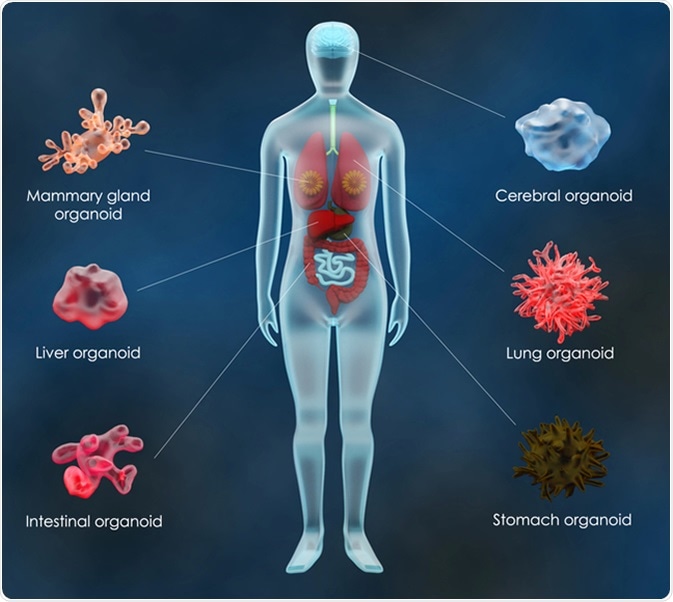One of the ways to understand tissue organization and function is to recreate it ex vivo. This kind of experiment can provide insights into what kinds of cells and signaling is critical for the development and function of a tissue or organ.
This attempt to create tissues and organs outside the body led to the creation of organoids which are self-organized, three-dimensional tissues, although they mostly represent partial regions of a tissue.

Human organoids. Image Credit: Meletios Verras / Shutterstock
Generation of Organoids
Organoids can be generated from both pluripotent stem cells (PSC) and adult stem cells (ASC). Using three dimensional scaffolds which will provide the substratum for the cells to grow and signaling molecules, scientists have shown the formation of self-organized optic cups, brain, intestine, liver, and kidney. The factors to be considered when growing cells in to independent three-dimensional structures are the following:
- scaffolds;
- cell-cell interaction;
- spatiotemporal control of signaling;
- vascularization or blood supply.
3D Cell Culture and Analysis: Thoughts from Laura Broutier, PhD
Scaffolds or Extracellular Matrix (ECM)
ECM is one of the critical components of the stem cell niche. It provides structural support and mediates signaling for cell differentiation. ECM includes laminin, fibronectin, and collagen. It can be simulated either using synthetic three-dimensional scaffolds with similar topology or by using decellularized matrices which are matrices from which cells have been isolated such that only the ECM scaffold is left behind.
Synthetic scaffolds
Synthetic scaffolds can be created from polyacrylamide and polyethylene glycol (PEG) or natural molecules such as agarose or collagen.
Microcontact patterned scaffolds
Apart from the substrate, cell signaling is also a crucial part of ECM. To this end, microcontact patterning has been devised. In this method, signaling proteins, ECM, and cells are imprinted on a hydrogel substrate. An engineered ECM should also have similar physical features as the native ECM. To do this, several methods such as electron gun have been used to generate similar features on the surface of the ECM as the native surface.
Stiffness of the scaffolds
ECM also provides mechanical signaling apart from the chemical signaling. The stiffness of the substrate has been modified to simulate the mechanical signaling of ECM. This can be done by creating additional or reducing crosslinks in the matrix which increase or decrease its stiffness.
Spatiotemporal control
During development and formation of organs, precise chemical signals are present in specific places and at specific times. This spatiotemporal control of signaling is crucial for organogenesis. Three-dimensional cultures have biochemical signals but there is no control on its location and time. One of the ways this has been overcome is by using light-mediated patterning. In this method, using light or photoactivation, signaling molecules can be activated at specific time, place, and pattern.
Vascularization
Apart from having necessary substratum and signaling, another critical element is the blood and oxygen supply in the engineered tissues. Inside the body, all cells have ensured blood and oxygen supply due to a branched vascular network. Thus, integrating blood vessels in to the organoid is another critical requirement.
Seeding endothelial cells
One of the methods is to seed endothelial cells in to the organoid system to generate new blood vessels along with the tissues.
Micro-engineered blood vessels
Another method is creating micro-engineered, 3D structures similar to blood vessels in the scaffold of the organoids. Sometimes, the engineered tissues are small enough such that blood and oxygen supply can occur through the process of diffusion.
Further Reading
Last Updated: Jul 19, 2023